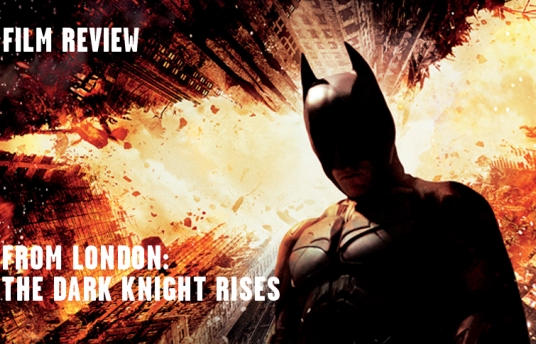From London: The Dark Knight Rises
Jul 19, 2012

By Oliver Good in London
Film: The Dark Knight Rises
Director: Christopher Nolan
Starring: Christian Bale, Tom Hardy, Anne Hathaway, Gary Oldman, Michael Caine, Joseph Gordon-Levitt, Marion Cotillard
Genre: Action/Adventure/Science-fiction
Running Time: 165 mins
One of the most enduring scenes of 2008’s “The Dark Knight” sees Batman’s arch nemesis, The Joker, terrorising Gotham by blowing-up a hospital. In this, the film’s fervently anticipated sequel, antagonist Bane engages in supervillain oneupmanship; with just the flick of a switch, we see him reduce half of the city’s infrastructure to rubble.
The difference between the two spectacles of destruction demonstrates the scaling-up that has taken place. Christopher Nolan’s third and emphatically final Batman movie offers more characters than its predecessor and manages to add to its ample running time. Gorgeously rendered and packed with nail-biting action sequences, it also seems to take place on a broader canvas (particularly if viewed in IMAX, as the director intended) from the depths of the city’s sewers to above the roofs of its skyscrapers.
Hulking villain Bane (Tom Hardy) would make Heath Ledger’s hunched Joker look like a child if the pair stood side-by-side, and the film attempts to grapple with more than a few big ideas too. This litany of enlargements also mirrors the level of anticipation which has surrounded “The Dark Knight Rises’ release”; greater than perhaps any blockbuster in history.
One exception to the super-sizing rule is Bruce Wayne (Christian Bale) himself. The story picks-up eight years after the events of its predecessor, which forced Gotham’s protector to hang-up his cape. The years have been tough on the now-reclusive billionaire, who exists in a state of atrophy. But Bane’s activities bring him out of retirement with a bang. We’re introduced to the masked mercenary in a spectacular mid-air hijacking; the head-spinning setpiece demonstrates some of the gravity-defying tricks Nolan learned while making his recent masterpiece, Inception.
But although Bane scores an early triumph over Batman, winning over audiences will prove more difficult. He may be physically menacing, and in possession of a plan more diabolical than anything The Joker dreamt-up, but the muscleman lacks many of the real-world resonances of Nolan’s previous villains, (Batman Begins’ Ra’s al Ghul, portrayed by Liam Neeson, was partly modeled on Osama bin Laden). Then there’s his only-intermittently-decipherable dialogue, which has the unfortunate tone of Bond villain Blofeld speaking through Darth Vader’s voicebox.
But fixating on Bane, or even Batman, does the film a disservice (the latter is absent for almost the entire middle section of the movie). Taking inspiration from Fritz Lang’s silent epic “Metropolis”, this is the story of an entire city, and one that attempts to show how even ordinary people can become heroes – an idea which Joseph Gordon-Levitt’s beat cop John Blake comes to embody.
In its opening act, the film shudders under the weight of its characters, but slowly the chess pieces are moved into position for a tantalising battle of wills. Gary Oldman and Michael Caine both play an essential role in keeping the story grounded, and while Anne Hathaway’s Catwoman could feel extraneous, her energetic and seductive turn provides a prefect counter to the frequently morose events that unfold. One might expect Christian Bale to be phoning-in his performances by now, but the almost Homeric odyssey upon which Wayne embarks means the actor rarely revisits old ground. Each character helps to drive the story towards a breathtaking crescendo which will leave few fans of the series disappointed, and elegantly calls back to the saga’s origins.
Many gave-up comparing Nolan’s Batman movies to the rest of the superhero genre years ago, and indeed this has more in common with “The Godfather” than it does “The Amazing Spider-Man”. But the comparison from which it will suffer most is to its direct predecessor. After making a film that can legitimately claim the finest villain in the history of cinema, it’s hard to shake the notion that Nolan’s newfound obsession with size and spectacle is an attempt at filling a Heath Ledger-shaped hole. While it may feel less complete than “The Dark Knight”, this final chapter is the undoubtedly the grandest and most ambitious outing in what is sure to be remembered for decades to come as the definite Batman saga.
The Dark Knight Rises - Trailer
إعلان فيلم ذا دارك نايت رايزس